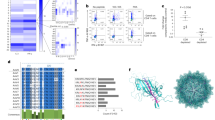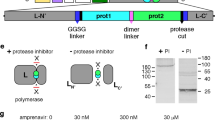Abstract
Human Orthoreovirus Type 3 Dearing is not pathogenic to humans and has been evaluated clinically as an oncolytic agent. Its transduction efficiency and the tumor cell selectivity may be enhanced by incorporating ligands for alternative receptors. However, the genetic modification of reoviruses has been difficult, and genetic targeting of reoviruses has not been reported so far. Here we describe a technique for generating genetically targeted reoviruses. The propagation of wild-type reoviruses on cells expressing a modified σ1-encoding segment embedded in a conventional RNA polymerase II transcript leads to substitution of the wild-type genome segment by the modified version. This technique was used for generating reoviruses that are genetically targeted to an artificial receptor expressed on U118MG cells. These cells lack the junction adhesion molecule-1 and therefore resist infection by wild-type reoviruses. The targeted reoviruses were engineered to carry the ligand for this receptor at the C terminus of the σ1 spike protein. This demonstrates that the C terminus of the σ1 protein is a suitable locale for the insertion of oligopeptide ligands and that targeting of reoviruses is feasible. The genetically targeted viruses can be propagated using the modified U118MG cells as helper cells. This technique may be applicable for the improvement of human reoviruses as oncolytic agents.
This is a preview of subscription content, access via your institution
Access options
Subscribe to this journal
Receive 12 print issues and online access
$259.00 per year
only $21.58 per issue
Buy this article
- Purchase on Springer Link
- Instant access to full article PDF
Prices may be subject to local taxes which are calculated during checkout








Similar content being viewed by others
Accession codes
References
Norman KL, Lee PW . Not all viruses are bad guys: the case for reovirus in cancer therapy. Drug Discov Today 2005; 10: 847–855.
Forsyth P, Roldan G, George D, Wallace C, Palmer CA, Morris D et al. A phase I trial of intratumoral administration of reovirus in patients with histologically confirmed recurrent malignant gliomas. Mol Ther 2008; 16: 627–632.
Coffey MC, Strong JE, Forsyth PA, Lee PW . Reovirus therapy of tumors with activated Ras pathway. Science 1998; 282: 1332–1334.
Etoh T, Himeno Y, Matsumoto T, Aramaki M, Kawano K, Nishizono A et al. Oncolytic viral therapy for human pancreatic cancer cells by reovirus. Clin Cancer Res 2003; 9: 1218–1223.
Kilani RT, Tamimi Y, Hanel EG, Wong KK, Karmali S, Lee PW et al. Selective reovirus killing of bladder cancer in a co-culture spheroid model. Virus Res 2003; 93: 1–12.
Norman KL, Lee PW . Reovirus as a novel oncolytic agent. J Clin Invest 2000; 105: 1035–1038.
Norman KL, Hirasawa K, Yang AD, Shields MA, Lee PW . Reovirus oncolysis: the Ras/RalGEF/p38 pathway dictates host cell permissiveness to reovirus infection. Proc Natl Acad Sci USA 2004; 101: 11099–11104.
Tyler KL, Fields BN . Mammalian reoviruses. In: Knipe DM, Howely PM (eds). Fields Virology, 4th edn. Lippincott Williams & Wilkins: Philadelphia, 2001, pp 1729–1745.
Barton ES, Forrest JC, Connolly JL, Chappell JD, Liu Y, Schnell FJ et al. Junction adhesion molecule is a receptor for reovirus. Cell 2001; 104: 441–451.
Barton ES, Connolly JL, Forrest JC, Chappell JD, Dermody TS . Utilization of sialic acid as a coreceptor enhances reovirus attachment by multistep adhesion strengthening. J Biol Chem 2001; 276: 2200–2211.
Forrest JC, Campbell JA, Schelling P, Stehle T, Dermody TS . Structure-function analysis of reovirus binding to junctional adhesion molecule 1. Implications for the mechanism of reovirus attachment. J Biol Chem 2003; 278: 48434–48444.
Lee PW, Leone G . Reovirus protein sigma 1: from cell attachment to protein oligomerization and folding mechanisms. Bioessays 1994; 16: 199–206.
Danthi P, Hansberger MW, Campbell JA, Forrest JC, Dermody TS . JAM-A-independent, antibody-mediated uptake of reovirus into cells leads to apoptosis. J Virol 2006; 80: 1261–1270.
Lee PW, Gilmore R . Reovirus cell attachment protein sigma 1: structure–function relationships and biogenesis. Curr Top Microbiol Immunol 1998; 233 (Part 1): 137–153.
Nibert ML, Dermody TS, Fields BN . Structure of the reovirus cell-attachment protein: a model for the domain organization of sigma 1. J Virol 1990; 64: 2976–2989.
Turner DL, Duncan R, Lee PW . Site-directed mutagenesis of the C-terminal portion of reovirus protein sigma 1: evidence for a conformation-dependent receptor binding domain. Virology 1992; 186: 219–227.
Maginnis MS, Forrest JC, Kopecky-Bromberg SA, Dickeson SK, Santoro SA, Zutter MM et al. Beta1 integrin mediates internalization of mammalian reovirus. J Virol 2006; 80: 2760–2770.
Nibert ML, Schiff LA . Reoviruses and their replication. In: Knipe DM, Howely PM (eds). Fields Virology, 4th edn. Lippincott Williams & Wilkins: Philadelphia, 2001, pp 1679–1728.
Roner MR, Steele BG . Localizing the reovirus packaging signals using an engineered m1 and s2 ssRNA. Virology 2007; 358: 89–97.
Chen D, Zeng CQ, Wentz MJ, Gorziglia M, Estes MK, Ramig RF . Template-dependent, in vitro replication of rotavirus RNA. J Virol 1994; 68: 7030–7039.
Komoto S, Sasaki J, Taniguchi K . Reverse genetics system for introduction of site-specific mutations into the double-stranded RNA genome of infectious rotavirus. Proc Natl Acad Sci USA 2006; 103: 4646–4651.
Patton JT, Spencer E . Genome replication and packaging of segmented double-stranded RNA viruses. Virology 2000; 277: 217–225.
Roner MR, Bassett K, Roehr J . Identification of the 5′ sequences required for incorporation of an engineered ssRNA into the Reovirus genome. Virology 2004; 329: 348–360.
Van Houdt WJ, Smakman N, van den Wollenberg DJM, Hoeben RC, Borel Rinkes IHM, Kranenburg O . Transient infection of freshly isolated human colorectal tumor cells by Reovirus T3D intermediate subviral particles. Cancer Gene Ther 2008; 15: 284–292; doi:10.1038/cgt.2008.2.
Waehler R, Russell SJ, Curiel DT . Engineering targeted viral vectors for gene therapy. Nat Rev Genet 2007; 8: 573–587.
Roner MR, Joklik WK . Reovirus reverse genetics: incorporation of the CAT gene into the reovirus genome. Proc Natl Acad Sci USA 2001; 98: 8036–8041.
Kobayashi T, Antar AAR, Boehme KW, Danthi P, Eby EA, Guglielmi KM et al. A plasmid-based reverse genetics system for animal double-stranded RNA viruses. Cell Host Microbe 2007; 1: 147–157.
Wilcox ME, Yang W, Senger D, Rewcastle NB, Morris DG, Brasher PM et al. Reovirus as an oncolytic agent against experimental human malignant gliomas. J Natl Cancer Inst 2001; 93: 903–912.
Campbell JA, Schelling P, Wetzel JD, Johnson EM, Forrest JC, Wilson GA et al. Junctional adhesion molecule a serves as a receptor for prototype and field-isolate strains of mammalian reovirus. J Virol 2005; 79: 7967–7978.
Stehle T, Dermody TS . Structural similarities in the cellular receptors used by adenovirus and reovirus. Viral Immunol 2004; 17: 129–143.
Lindner P, Bauer K, Krebber A, Nieba L, Kremmer E, Krebber C et al. Specific detection of his-tagged proteins with recombinant anti-His tag scFv-phosphatase or scFv-phage fusions. Biotechniques 1997; 22: 140–149.
Douglas JT, Miller CR, Kim M, Dmitriev I, Mikheeva G, Krasnykh V et al. A system for the propagation of adenoviral vectors with genetically modified receptor specificities. Nat Biotechnol 1999; 17: 470–475.
Cashdollar LW, Chmelo RA, Wiener JR, Joklik WK . Sequences of the S1 genes of the three serotypes of reovirus. Proc Natl Acad Sci USA 1985; 82: 24–28.
Chappell JD, Barton ES, Smith TH, Baer GS, Duong DT, Nibert ML et al. Cleavage susceptibility of reovirus attachment protein sigma1 during proteolytic disassembly of virions is determined by a sequence polymorphism in the sigma1 neck. J Virol 1998; 72: 8205–8213.
Yin P, Keirstead ND, Broering TJ, Arnold MM, Parker JS, Nibert ML et al. Comparisons of the M1 genome segments and encoded mu2 proteins of different reovirus isolates. Virol J 2004; 1: 6.
Castro C, Arnold JJ, Cameron CE . Incorporation fidelity of the viral RNA-dependent RNA polymerase: a kinetic, thermodynamic and structural perspective. Virus Res 2005; 107: 141–149.
Jane-Valbuena J, Nibert ML, Spencer SM, Walker SB, Baker TS, Chen Y et al. Reovirus virion-like particles obtained by recoating infectious subvirion particles with baculovirus-expressed sigma 3 protein: an approach for analyzing sigma 3 functions during virus entry. J Virol 1999; 73: 2963–2973.
Vellinga J, Rabelink MJWE, Cramer SJ, van den Wollenberg DJM, Van der Meulen H, Leppard KN et al. Spacers increase the accessibility of peptide ligands linked to the carboxyl terminus of adenovirus minor capsid protein IX. J Virol 2004; 78: 3470–3479.
Vellinga J, de Vrij J, Myhre S, Uil T, Martineau P, Lindholm L et al. Efficient incorporation of a functional hyper-stable single-chain antibody fragment protein-IX fusion in the adenovirus capsid. Gene Therapy 2007; 14: 664–670.
Chen D, Patton JT . Rotavirus RNA replication requires a single-stranded 3′ end for efficient minus-strand synthesis. J Virol 1998; 72: 7387–7396.
Shmulevitz M, Marcato P, Lee PW . Unshackling the links between reovirus oncolysis, Ras signaling, translational control and cancer. Oncogene 2005; 24: 7720–7728.
Stehle T, Dermody TS . Structural evidence for common functions and ancestry of the reovirus and adenovirus attachment proteins. Rev Med Virol 2003; 13: 123–132.
Kobayashi T, Chappell JD, Danthi P, Dermody TS . Gene-specific inhibition of reovirus replication by RNA interference. J Virol 2006; 80: 9053–9063.
Roy P . Orbiviruses. In: Knipe DM, Howely PM (eds). Fields Virology. Lippincott Williams and Wilkins: Philadelphia, 2001, pp 1835–1869.
Kapikian AZ, Hoshino Y, Chanock RM . Rotaviruses. In: Knipe DM, Howely PM (eds). Fields Virology. Lippincott Williams and Wilkins: Philadelphia, 2001, pp 1787–1833.
Fallaux FJ, Kranenburg O, Cramer SJ, Houweling A, van Ormondt H, Hoeben RC et al. Characterization of 911: a new helper cell line for the titration and propagation of early region 1-deleted adenoviral vectors. Hum Gene Ther 1996; 7: 215–222.
Smakman N, van den Wollenberg DJM, Elias SG, Sasazuki T, Shirasawa S, Hoeben RC et al. KRAS(D13) Promotes apoptosis of human colorectal tumor cells by ReovirusT3D and oxaliplatin but not by tumor necrosis factor-related apoptosis-inducing ligand. Cancer Res 2006; 66: 5403–5408.
Vellinga J, Uil TG, de Vrij J, Rabelink MJ, Lindholm L, Hoeben RC . A system for efficient generation of adenovirus protein IX-producing helper cell lines. J Gene Med 2006; 8: 147–154.
Naik UP, Naik MU, Eckfeld K, Martin-DeLeon P, Spychala J . Characterization and chromosomal localization of JAM-1, a platelet receptor for a stimulatory monoclonal antibody. J Cell Sci 2001; 114 (Part 3): 539–547.
Carlotti F, Bazuine M, Kekarainen T, Seppen J, Pognonec P, Maassen JA et al. Lentiviral vectors efficiently transduce quiescent mature 3T3-L1 adipocytes. Mol Ther 2004; 9: 209–217.
Virgin HW, Mann MA, Fields BN, Tyler KL . Monoclonal antibodies to reovirus reveal structure/function relationships between capsid proteins and genetics of susceptibility to antibody action. J Virol 1991; 65: 6772–6781.
Acknowledgements
We thank Martijn Rabelink and Cynthia Sitaram for their expert technical assistance. We gratefully acknowledge Drs Lee Fradkin, Hans Tanke, Danijella Koppers-Lalic and Twan de Vries for their helpful discussions and critical reading of the manuscript.
Author information
Authors and Affiliations
Corresponding author
Rights and permissions
About this article
Cite this article
van den Wollenberg, D., van den Hengel, S., Dautzenberg, I. et al. A strategy for genetic modification of the spike-encoding segment of human reovirus T3D for reovirus targeting. Gene Ther 15, 1567–1578 (2008). https://doi.org/10.1038/gt.2008.118
Received:
Revised:
Accepted:
Published:
Issue Date:
DOI: https://doi.org/10.1038/gt.2008.118
Keywords
This article is cited by
-
The artificial amino acid change in the sialic acid-binding domain of the hemagglutinin neuraminidase of newcastle disease virus increases its specificity to HCT 116 colorectal cancer cells and tumor suppression effect
Virology Journal (2024)
-
Reovirus combined with a STING agonist enhances anti-tumor immunity in a mouse model of colorectal cancer
Cancer Immunology, Immunotherapy (2023)
-
Gastrointestinal cancer-associated fibroblasts expressing Junctional Adhesion Molecule-A are amenable to infection by oncolytic reovirus
Cancer Gene Therapy (2022)
-
Arming oncolytic reovirus with GM-CSF gene to enhance immunity
Cancer Gene Therapy (2019)
-
Pre-surgical neoadjuvant oncolytic virotherapy confers protection against rechallenge in a murine model of breast cancer
Scientific Reports (2019)



